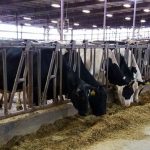
This is more than earned by forestry, meat and wool combined, he says in a DairyNZ column.
“The entire economy benefits from dairy spending, directly, as in what dairy farmers and dairy companies buy from businesses NZ-wide and indirectly.
“Dairy significantly helps to fill Government’s tax coffers too, providing more money to pay for the essential services that help to improve people’s quality of life – education, hospitals, social security and welfare, police, etc.”
DairyNZ estimates that in the 2018-19 year dairy farmers paid $0.5 billion in taxes. For the 2019-20 year they will likely pay even more.
Dairy also pays regional government rates and other charges, helping to pay for local infrastructure and services. Farmers last year alone paid $200 million in rates.
The dairy sector employs 46,000 workers, equal to the entire population of Timaru, Canterbury’s second largest city, or of Upper Hutt.
On farm there are 34,000 full-time equivalent employees and 12,000 more in 35 dairy processing plants.
Dairy sector employment has grown faster (+3.1% per year) since 2000 than the rate of national job creation (+1.8% per year), boosting rural communities.
Every New Zealander is better off today thanks to the nation’s dairy cows and will continue to be better off in the future too, he says.
“The nutritional benefits of dairy to the human body as part of a balanced diet are factually documented. Dairy is also central to many of our culinary cultures, eg crumbly cheddar, smooth brie, ice cream, yoghurts and butter.”
Doole says milk helps improve lives, eg helping to pay for goods and services, and helping to reduce the price of others including imported items.
“And dairy farmers, who are innovators and responsive to the signals they receive, are improving their environmental practices, eg fencing and riparian planting to protect waterways, upgrading effluent systems, or working to reduce greenhouse gases.
“They are also playing a key role in communities as they work together to address issues of water quality.”
Regional stats
Northland: dairy, either farming or processing, generated $500 million in regional GDP and provided 2800 jobs.
Waikato: $2.2 billion in regional GDP and 13,400 jobs.
Bay of Plenty: $500m in regional GDP and 2800 jobs.
Taranaki: $950m in regional GDP and 5500 jobs.
Lower North Island: $700m in regional GDP and 4400 jobs.
West Coast-Tasman: $260m in regional GDP and 2100 jobs.
Marlborough-Canterbury: $1.5b in regional GDP and 8500 jobs.
Otago-Southland: $1.1b in regional GDP and 6100 jobs.

























